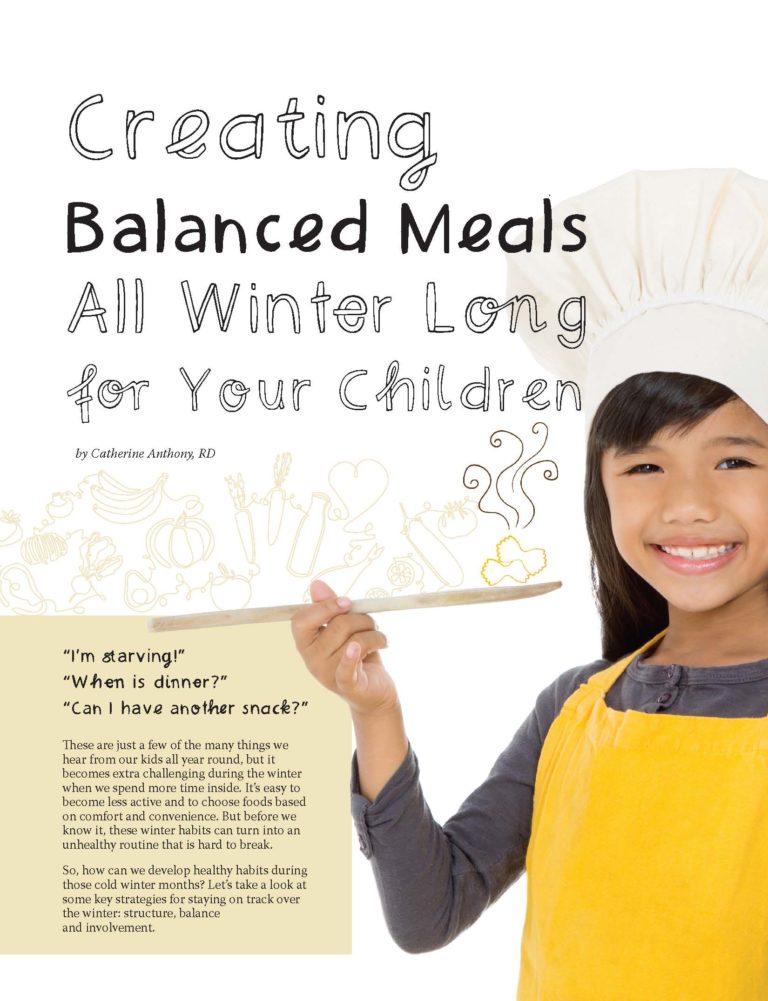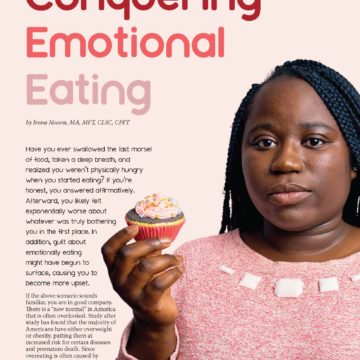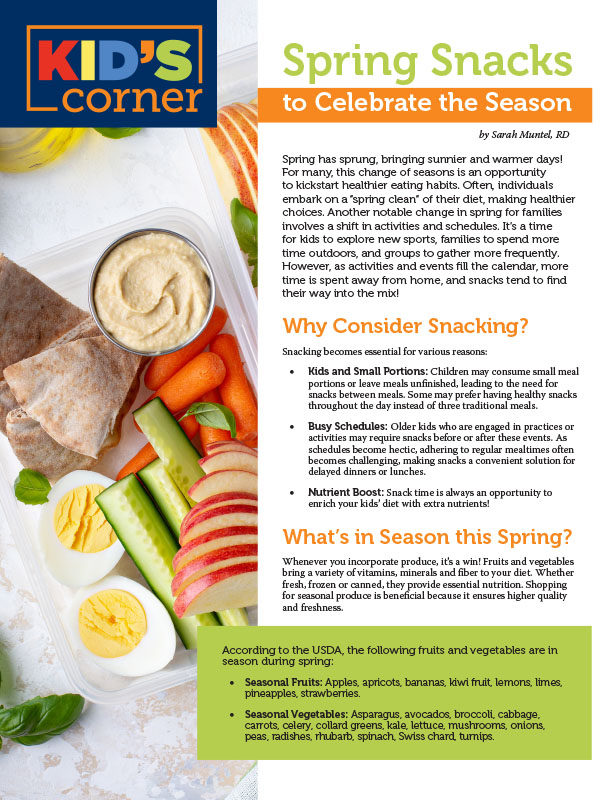Creating Balanced Meals All Winter Long for Your Children


by Catherine Anthony, RD
Winter 2023
“I’m starving!”
“When is dinner?”
“Can I have another snack?”
These are just a few of the many things we hear from our kids all year round, but it becomes extra challenging during the winter when we spend more time inside. It’s easy to become less active and to choose foods based on comfort and convenience. But before we know it, these winter habits can turn into an unhealthy routine that is hard to break.
So, how can we develop healthy habits during those cold winter months? Let’s take a look at some key strategies for staying on track over the winter: structure, balance and involvement.
Structure
During the winter, we often spend more time at home. Kids may find themselves frequently eating or “grazing” throughout the day or skipping meals and eating large portions later on. How can we solve this? One strategy is to have structured meal and snack times to help create a routine for your family. A typical day should involve three meals and one to three snacks based on your child’s age and stage of life. An example schedule could be something like this:
6:00-7:00 am – Breakfast
9:30-10:30 am – Snack
12:00-1:00 pm – Lunch
2:30-3:30 pm – Snack
6:00-7:00 pm – Dinner
These times may vary by time of year or your family’s schedule. Setting your own schedule ensures an easier answer to “When is dinner?” or “Can I have another snack?” By answering these questions with the time of the next meal or snack that you’ve planned out, you can create a more predictable routine. Posting this schedule on your fridge and making it visible can help remind everyone when meal and snack times are.
Balance
Are you tired of hearing your child say, “I don’t want that,” or “Can I have ice cream now?” 15 minutes after they didn’t finish their dinner? Meals and snacks that lack balance can lead to a cycle of hunger. Balancing meals and snacks can help provide your child with what they need to thrive and prevent them from being hungry all day long. The goal of balanced eating is to get the right types and amounts of foods from each food group. Aim for a plate that is:
- ½ fruits and/or non-starchy vegetables:
Examples: bananas, oranges, strawberries, pears, broccoli, green beans, carrots, lettuce, tomatoes, etc.
- ¼ protein:
Examples: meat, fish, eggs, beans, legumes, etc.
- ¼ carbohydrates:
Examples: bread, pasta, tortillas, crackers, potatoes, corn, etc.
This style of eating is shown in the MyPlate method of eating developed by the United States Department of Agriculture (USDA). More information on MyPlate can be found at MyPlate.gov.
Meal Ideas & Recipes:
Balanced Breakfast Ideas:
*The portion and frequency will depend on the age of your child.
- Plain or low-sugar oatmeal + fruit + peanut butter + a glass of milk
- Toast (whole wheat or whole grain) + an egg + fruit + low-sugar yogurt
- For on-the-go: dry low-sugar cereal (look for single digits of added sugar) + boiled egg + string cheese + fruit
Balanced Lunch Ideas:
- Turkey and cheese sandwich on whole wheat bread + banana + cucumber slices
- Peanut butter + banana sandwich on whole wheat bread + low-sugar yogurt + celery
- Lean lunch meat of choice + cheese cubes + wheat crackers + carrots + grapes
Balanced Snack Ideas:
- Fruit + nut butter
- ½ peanut butter sandwich
- String cheese + light popcorn
- Cheese + wheat crackers
- Cottage cheese + fruit
- Low-sugar yogurt + fruit
- ½ of a lean lunchmeat and cheese sandwich
Balanced Dinner Idea:
Double Vegetable Fried Rice
Adapted from ChopChopFamily.org
Ingredients:
- 1 Tbsp. toasted sesame oil (or vegetable oil)
- 3 scallions, chopped, whites and greens kept separate
- 2 celery ribs, including the leaves, chopped
- 3 cups assorted sliced or diced vegetables, such as bell peppers, zucchini, cabbage, broccoli and mushrooms
- 3 cups cooked brown rice
- 1 tsp. vegetable oil
- 2 large eggs, beaten
- 4 cups baby kale or spinach
- ½ cup frozen peas
- 2 tsps. low-sodium soy sauce
- 1 Tbsp. toasted sesame seeds (optional)
- ¼ tsp. crushed red pepper (optional)
Directions:
- Heat a large skillet on medium-high.
- When the skillet is hot (if you flick water on it, the water should dance and evaporate), add the sesame oil, scallion whites, celery and assorted vegetables and cook, stirring once, until they start to brown, 3–5 minutes.
- Add the rice and stir until everything is well-mixed and heated through. Lower the heat to medium-low.
- Push the rice to one side of the skillet and add the vegetable oil. When the oil is hot, add the eggs and cook until set, about 1 minute, scrambling as you go. Mix the eggs into the rice.
- Add the scallion greens, kale or spinach, frozen peas, 2 Tbsp. soy sauce, vinegar, sesame seeds, and optional crushed red pepper. Mix well.
- Cook until the kale or spinach is wilted, about 2 minutes. Taste the fried rice. Does it need another tiny splash of soy sauce? If so, add some and taste it again until you’ve achieved your desired flavor. Serve right away.
Picking Snacks
When choosing snacks, aim to include at least two food groups. Choose foods with both fiber and protein to help your family feel fuller for longer.
- Fiber:
Examples: whole grains, fruit, vegetables, beans, legumes, popcorn, etc.
- Protein:
Examples: cheese, yogurt, nuts, nut butter, milk, meat, cottage cheese, fish, eggs, etc.
*You will find balanced breakfast, lunch, dinner and snack ideas in this article.
Involvement
Research shows that involving kids in the planning, preparation and cooking process can encourage them to try new and healthy foods. The level of involvement will depend on the age and stage of your child, but nonetheless, involving them is a great way to engage their curiosity and develop healthy eating habits they will carry into the future. Visit EatRight.org/food/home-food-safety/safe-cooking-and-prep/teaching-kids-to-cook for specific ways to get your children involved in the kitchen depending on their current stage of life.
Conclusion
Winter can pose a challenge to healthy eating, but it doesn’t have to! Consider this the perfect time to develop new habits with your family that will encourage wellness all year long. Strive for structure, balance and involvement as you look for ways to keep your family healthy and engaged this winter.
About the Author:
Catherine Anthony, RD, is a registered dietitian from Cincinnati, Ohio. She works in a family-based pediatric weight management clinic and is passionate about providing education on how to make healthy eating more fun and practical for families.
by Sarah Muntel, RD Spring 2024 Spring has sprung, bringing sunnier and warmer days! For many, this…
Read Articleby Robyn Pashby, PhD Winter 2024 “No one is ever going to date you if you don’t…
Read Articleby Michelle “Shelly” Vicari Winter 2024 Winter has arrived! Don’t allow the chilly and damp weather to…
Read Article








